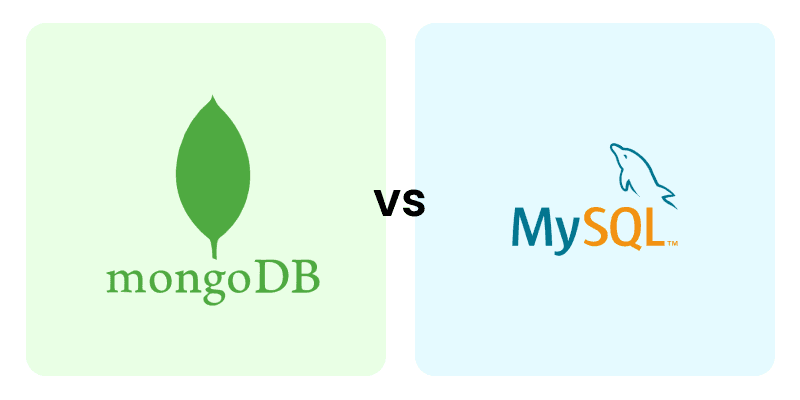Comparing The Differences - MongoDB Vs MySQL

Choosing the right database system is critical for any business or project.
Two of the most widely used database systems are MongoDB and MySQL.
Both are open-source and free to use, but they differ significantly in storing and managing data.
This article will compare MongoDB and MySQL in depth, exploring their features, advantages, disadvantages, and ideal use cases.
What is MongoDB?
MongoDB is a leading NoSQL database designed to handle unstructured and semi-structured data.
It stores data in flexible, JSON-like documents known as BSON (Binary JSON).
This allows developers to store varying types of data without needing a fixed schema, offering greater adaptability.

Key Features of MongoDB
- Document-Oriented Storage: Data is stored in collections of documents with key-value pairs.
- Dynamic Schemas: Each document can have a different structure, enabling flexibility.
- Horizontal Scalability: Easily scales out by distributing data across multiple servers using sharding.
- High Availability: Replica sets provide data redundancy and automatic failover.

Advantages of MongoDB
A flexible data model supports fast iterations and agile development.
Simplifies handling large volumes of data with varying structures.
Excellent horizontal scalability with sharding.
Faster performance for insert-heavy workloads.
Disadvantages of MongoDB
- Less efficient for complex transactions requiring multiple document updates.
- Lacks the built-in referential integrity of relational databases.
- Requires careful schema design to avoid performance issues.
- Potential for increased memory usage due to data duplication, as it does not enforce normalization like relational databases.
What is MySQL?
MySQL is a robust, open-source relational database management system (RDBMS) developed by Oracle.
It organizes data into structured tables and uses Structured Query Language (SQL) to interact with the data.
MySQL requires a well-defined schema, meaning you must design the database structure (tables, columns, data types) before adding data.
This strict organization ensures data consistency and integrity but can make adapting to new data types or formats challenging.

Key Features of MySQL
Open-Source: MySQL is open-source, allowing developers to use, modify, and distribute the software freely under the terms of its license.
- Cross-Platform Support: MySQL can run on various platforms, including Windows, Linux, macOS, and Unix, providing flexibility and compatibility across different environments.
- Data Integrity: Referential integrity ensures data accuracy and consistency.
- ACID Compliance: MySQL supports atomicity, consistency, isolation, and durability to ensure reliable transactions.
- SQL Support: MySQL uses SQL, a powerful language for querying and managing data.
- Relational Data Model: Data is stored in tables with rows and columns, making it easy to enforce relationships between data using foreign keys.
.svg)
Advantages of MySQL
High performance with optimized queries for structured data.
Strong community support and extensive documentation.
Ideal for applications that require complex transactions and relationships.
Mature technology with proven reliability.
Disadvantages of MySQL
- Less flexible due to predefined schemas.
- Schema migrations can be complex and time-consuming.
- Vertical scalability is limited compared to horizontal scaling.
- Performance can degrade with very large datasets and complex queries, especially without proper indexing.
Use Cases: When to Choose MongoDB or MySQL
When to Use MongoDB
Applications with evolving or unpredictable data structures (e.g., content management systems, social media platforms).
Big data projects require horizontal scalability.
Real-time analytics and high-speed data ingestion.
When to Use MySQL
Applications that require complex transactions and strict data integrity (e.g., banking systems, financial apps).
Systems with well-defined, structured data models.
Existing projects built on relational databases need maintenance or expansion.
Scalability Comparison
- MongoDB is designed for horizontal scalability, using sharding to distribute data across multiple servers.
- This makes it easier to scale out as the data grows.
- Additionally, replica sets in MongoDB ensure high availability and automatic failover.
- MySQL traditionally scales vertically by upgrading server resources.
- It supports read replicas, but these are primarily for read-heavy workloads.
- Write scalability can be limited unless using complex multi-master setups.
Performance Comparison
MySQL is optimized for read-heavy workloads and complex queries involving joins and transactions.
MongoDB excels in write-heavy operations, large data insertions, and applications that benefit from its flexible data model.
MongoDB's lack of complex joins can improve performance for certain use cases, while MySQL's indexing and query optimization benefit complex queries.
Flexibility Comparison
- MongoDB offers unmatched flexibility with its schemaless design, allowing developers to modify data structures without expensive schema migrations. This is ideal for projects where the data model is expected to change frequently.
- MySQL requires a rigid schema, making it more suitable for applications with well-defined data structures. Changing schemas can be time-consuming and may require significant planning.
Security Comparison
Both databases provide robust security features:
Role-Based Access Control (RBAC): Manage user permissions effectively.
Data Encryption: TLS/SSL for data in transit and encryption at rest.
Authentication: Integration with external authentication systems.
MongoDB offers advanced security options like Queryable Encryption, allowing encrypted searches without data decryption.
Conclusion
Both MongoDB and MySQL are powerful database systems with unique strengths. The right choice depends on your specific needs:
Choose MySQL for applications requiring structured data, complex queries, and strong transactional integrity.
Choose MongoDB for projects needing flexible data storage, horizontal scalability, and rapid development cycles.
For some projects, a hybrid approach combining both databases might be the best solution, leveraging the strengths of each system. Carefully assess your application requirements and growth plans to select the most suitable database.
